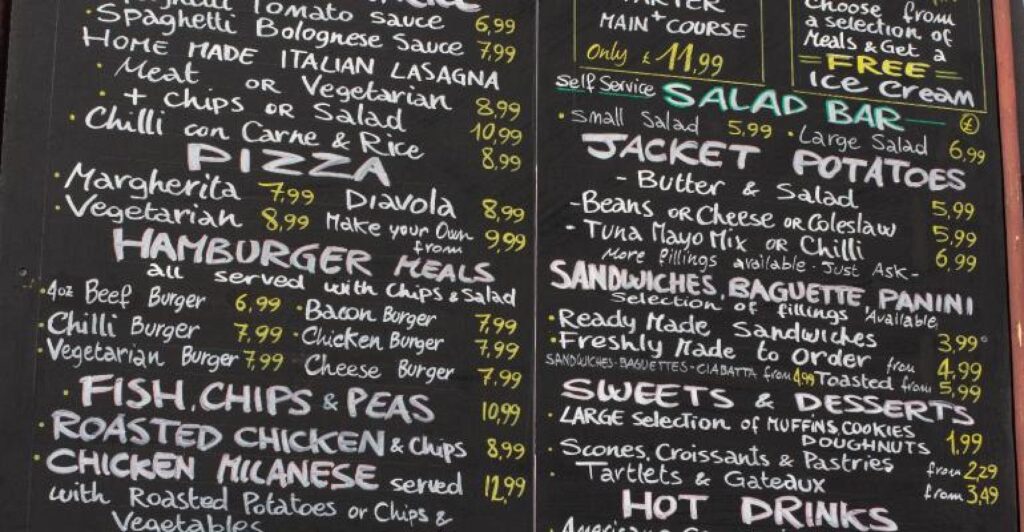Where does restaurant pricing land in 2024?
We may have reached consumers’ thresholds on menu prices and operators will need to find alternative solutions to offset higher costs to gain back some traffic.
08 December 2023
Share this exclusive content from Saladplate

As we face a new year, it’s perhaps time to have some difficult conversations. Chief among them: What should restaurant operators do about menu pricing?
Thus far, the 20-to-30% increases since the start of the pandemic have largely been justified to manage historically high inflation, rising labor prices and so forth. But most food costs have come back to earth, the supply chain continues to normalize, and grocery/supermarket prices have cooled materially. This confluence of trends seems to have put the restaurant industry in a bit of a pickle.
“A lot of pricing has been taken and there could be a substitution effect where people can instead go to a grocery store or convenience store. When hogs are high, people buy beef or chicken,” Kevin Burke, partner at Franchise Equity Partners, said in a recent interview. “Restaurant operators have to be careful not to get to a pricing plateau where you leave people behind out of sheer economics.”
Striking the right balance on price has always been a challenge, and that has never been truer than in this current environment defined by high inflation/rising wages coupled with a consumer that has shown a tremendous amount of willingness to pay more. That said, plenty of signs indicate we’ve reached – and perhaps even exceeded – such willingness and clearest among them is ebbing traffic. The so-called “substitution effect” could manifest accordingly, if it isn’t already.
“It’s becoming increasingly apparent that we face a challenging environment. According to Consumer Price Index data, Food Away from Home prices are trending at almost two percentage points higher than Food At Home prices. Historically, when FAH prices were significantly lower than FAFH prices, customer traffic took a hit. Unfortunately, current traffic trends are already 2.5% lower than they were in 2022 and almost 20% lower than they were in 2019, which adds significant pressure as brands plan for 2024,” said Richard Delvallée, SVP, Consulting, Revenue Management Solutions.
It seems these higher prices are having quite an impact on consumers’ experiences, which could – at least in part – explain recent traffic dips. For her research, consumer strategist Lisa Miller, author of the book, “The Business of Joy,” asks if the restaurant experience is worth it. Given the backdrop of these higher prices, the answer is increasingly becoming “no.”
“Basically, restaurants have been taking all this price, but have done nothing to add to the numerator. If you keep charging more but the experience, at best, might be the same, but in most instances, it’s worse, people will tap out. It won’t be worth it,” she said. “The math is simple – what you give has to be bigger than the denominator.”
So, now what? Headwinds remain strong, especially in California as AB 1228 is set to go into effect April 1 raising the hourly minimum wage to $20. Burke recommends a more intentional approach to the menu, “portion, mix – everything you can do besides sticker shock,” he said.
As Delvallée notes, managing steeper labor costs alongside traffic declines will require “strategic maneuvering” and “careful pricing strategies,” particularly if the grocery/restaurant gap widens.
“(RMS) recommends surgical pricing strategies incorporating purchasing patterns, bundling preferences and methods to re-engage lapsed customers,” he said. “Technology will play a significant role, too. AI-generated data supports competitive pricing strategies. Automation improves scheduling efficiencies. And brands that optimize their apps and other loyalty programs to keep high frequency customers engaged will have a significant advantage in an uncertain environment.”
Indeed, operators are clearly becoming more amenable to investments in technology platforms. According to a new survey from TD Bank, most operators (53%) plan on investing in such technologies, with digital platforms, mobile apps, and online ordering systems (51%) and operational automation (51%) as the biggest areas of focus. With these survey results in focus, Mark Wasilefsky, head of the Restaurant Franchise Finance Group at TD Bank, predicts we’ll see much more of this technology implemented in 2024 to combat higher costs without having to take more pricing.
“We’re starting to see some elimination of labor with kiosks, where there’s few people at the front counter. AI has been pretty successful at the drive-thru. It’s not the hamburger flipper, but the front end/backend technology we’re going to see more of. That is how operators are going to manage costs, at least in the short term,” he said. “We’re going to see technology continue to improve and I think restaurants, especially with AB 1228, are going to find a way to operate with less staff.”
However, therein lies another potential challenge; staffing directly correlates to experience. Miller’s research suggests that friendly service is more important than speed, including at QSRs – which could perhaps explain Chick-fil-A’s unequivocal success of late. Service is also king on the full-service side.
“Sixty-five percent of consumers are willing to pay higher prices and tips when there is exceptional service, not just because they feel obligated to pay more. People like to feel special and be cared for, and they’ll pay for it,” Miller said.
If there is a silver lining in this complicated pricing environment, it’s that intent – and optimism – remain high. RMS’ Q3 survey shows dine-in usage increasing versus the previous quarter, and younger generations, especially Gen Z (31%), intending to dine out more in the future. TD Bank’s survey shows that 66% of operators are optimistic about the future of the industry amid the current macroenvironment, while 55% feel confident their business will achieve positive traffic in 2024.
“The brands that will perform the strongest in 2024 are the ones that do a great job with pricing and keep their menus rationalized,” Wasilefsky said. “As long as we’re not facing any massive exogenous events, I think we’ll continue to see normalization and hopefully a nice, quiet year.”

Source: Nation’s Restaurant News



